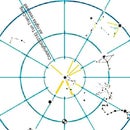Introduction: Locating the Sun by Polarizing Sunglasses.
by tonytran2015 (Melbourne, Australia)
Anti-glare polarizing sunglasses reduce ground reflected polarized rays. They can be used to locate the Sun even when it is hidden from view by clouds or by the horizon. In this way, they can even do the main task of "sky compass" and similar instruments.
Step 1: Basic Information
Two walkie-talkies are in the best condition for communication when their two antennas are parallel and at right angle to their line of view. The electric waves travelling between them have their electric field parallel to the emitting antenna and the varying electric field is at right angle to the line of transmission. The electromagnetic waves is said to be polarized in the direction of the emitting antenna.
Light is just electromagnetic waves at much higher frequencies than our familiar radio waves. Light can be polarized too. Light rays from incandescent sources are randomly polarized like radio waves coming from a walkie-talkie which is randomly orientated before each transmission. On the avarage we don't see any polarization from a source with randomly changing orientation. However after a partial reflection (accompanied by a partial transmission) at an interface between two transmission media, the reflected and the transmitted rays from an unpolarized ray are partially polarized.
Polarizing sunglasses can favour light polarized in one direction and dircriminate against light polarized in the other direction. With the same pair of sunglasses we can see two different colours and brightnesses depending on the orientation of the glasses when viewing the same source. This is illustrated in the following figure.
Be certain that your polarizing glasses really reduces sunlight reflecting off horizontal road surfaces before trying subsequent instructions here; each of the glasses must be individually tested and its direction of polarization verified.
Step 2: Different Colours and Brightnesses Seen From the Same Source of Light Through Polarizing Sunglasses
The cross with two different colours on the source denotes the two different colours seen through two orientations of the same sunglasses.
Step 3: Seeing the Polarized Lights of the Sky
Blue light from the sky is the result of Rayleigh scattering of photons from sunlight by molecules in the sky. This scattered light is highly polarized as seen in the following practice:
Search for a large clear patch of sky with no cloud. Look through the polarizing glasses. Rotate the glasses about the axis of view to see the sky lightens and darkens alternatingly with the angle of rotation. The darkening is most profound when the Sun is at right angle to the line of view.
Step 4: Locating the Hidden Sun.
1/- Search for a large clear patch of sky with no cloud. Rotate the glasses about the axis of view until the clear sky becomes most darkened. The Sun is then on the great circle perpendicular to the line joining the left and right spectacles (Being the intersection of the Celestial sphere and the symmetry plane of the sunglasses). The darkening is most profound when the Sun is at right angle to the line of view.
2/- Repeat with a second clear patch of the sky. Two large clear patches of the sky can give out the position of the hidden Sun. It is at the intersection of the two so obtained great circles in the sky.
3/- The position of the Sun below the sky-line can also be found using polarized light-rays from the clear sky above its (underground) line of view. If this picture is turned up side down with a horizon line added above its Sun it will illustrate how to find the Sun when it is below the horizon (The polarization is most profound on the clear sky at 90 degree to the (underground) line of view of the Sun.).
Reference [2] gives some interesting history of the early applications of polarization of light. Currently there have even been hypotheses that the Vikings had used polarized light to locate the Sun since antiquity with pieces of birefringent calcite crystals [3].
References.
[1]. Unknown Authors, Polarization (waves), Wikipedia, http://en.wikipedia.org/wiki/Polarization_%28wave... 26 May 2015
[2]. Unknown Authors, Following the Light of the Sky, polarization.net, https://www.polarization.com/compass/compass.html... Accessed 16 May 2015 05:40:14 GMT
[3]. Cahal Milmo, Not just the stuff of legend: Famed Viking ‘sunstone’ did exist, believe scientists, The Independent, http://www.independent.co.uk/news/science/archaeo... 06 March 2013, 21 May 2015
--THE END--











